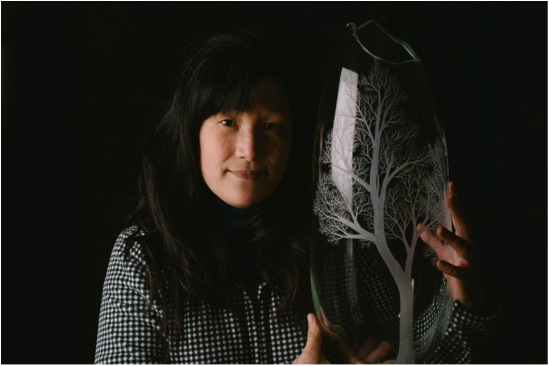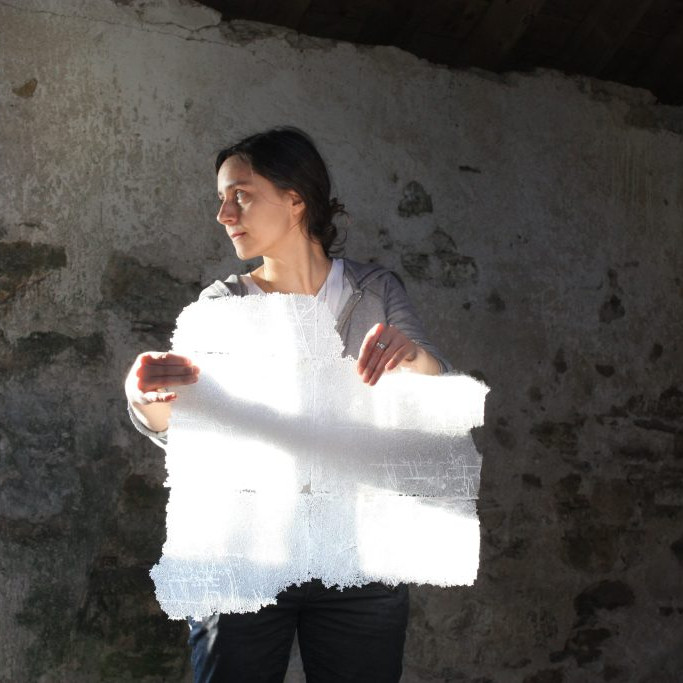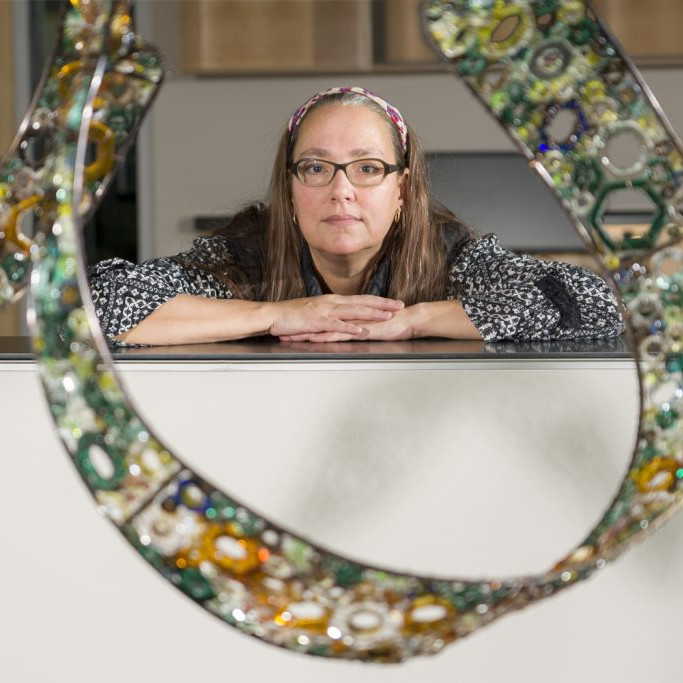Kayo Yokoyama Glass Artist - Blackheath, NSW, Australia
When you began your study at the Sydney University did you know then you wanted to be a glass artist?
Yes, I started blowing glass a year before attending Sydney University; I had a clear mind about studying art in glass.
Your glass is known for the engraving you do, on your own hand blown glass. Can you explain this technique?
Glass engraving is an old decorative glassworks technique. I use hand-held motor drills with small diamond tipped burrs, just like dentists use. Glass engraving is considered by many to be a dying art form; however I do not believe it is.
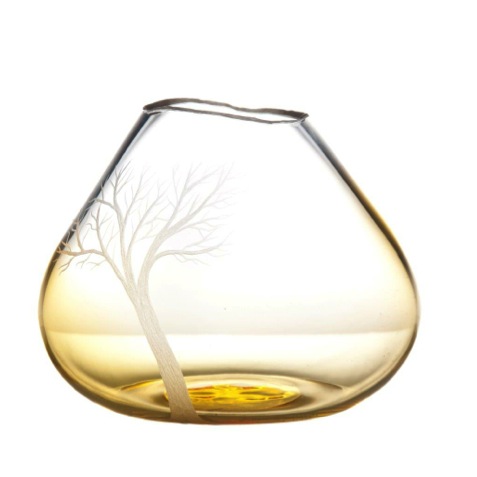
Lonely Tree
When you create a piece do you work toward a specific audience or exhibition?
Most of time, there are no particular reasons or audiences. Making comes from inside of me, to fulfil my desire.
Your medium glass is both fragile and hard can you discuss this?
Glass is a solid material and yet brittle. It is ensitive to temperature but is not easy to break by hand. I have a furnace which contains 220kg of molten glass, just like honey. When glass is hot, it can be cut, twisted and stretched but once it reaches certain temperature, it can’t be changed. It is a fascinating material.
When you engrave on your work you combine this along with meditation. How and why do you do this?
Buddhist Zen Master Dogen’s philosophy of concerning self-awareness and enlightenment is the core of my practice. His theory supports the discovery of the ‘self’ through meditation and mindfulness, and encapsulates an emphasis on providing greater understanding of the self. There are a few layers to this in my art practice: one of layer is when I engrave, it is a meditative process that directs my consciousness outside myself while the images create themselves.
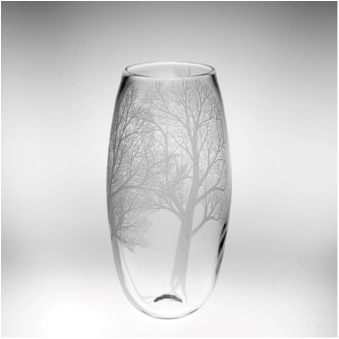
‘Legacy of the Day’
Homeland series
Your collection “Homeland” is all about space. Discuss how you achieve a landscape within a glass object?
The trees in my work represent real trees as well as being symbolic of a higher consciousness in the journey of the growth of my identity. My engraving of trees on the glass objects’ surface recalls me to a place of strength inside me. They suggest the fundamental order of the world and my place in it – my homeland. My feelings towards my homeland will be different from those of others, but through the use of shared symbolism my hope is that the others will find their own homeland through these artworks. My intention is similar to Master Dogen’s theory, ‘Let the object speak for itself’
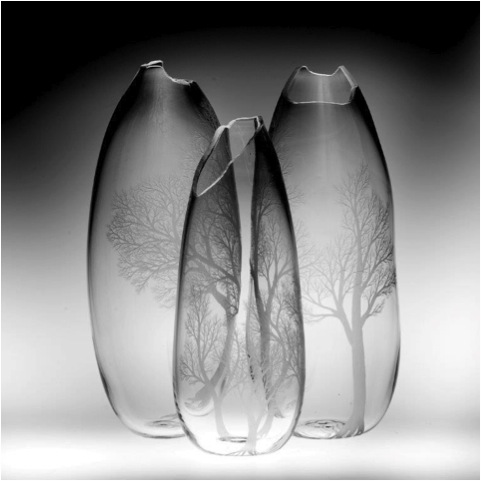
‘Homeland World Heritage’
Why have you added the chairs?
I use chairs as a metaphor for the self. A chair signifies the absence and the presence of a person. This idea is exemplified by a story from a Buddhist tale where the God ‘Mara’ sends his daughters and his army to distract the Sakayamuni (Buddha before he was ‘awakened’) when he sits in meditation under the Bodhi trees. One doesn’t see the person of the Buddha, only an empty seat, symbolizing his presence. It is dependent on the viewer what interpretation they give to the empty chair.
Do you make the chairs?
Sometimes; I have made them in silver nickel, silver, ceramic, glass and wood.
By using furniture you have been able to make your pieces take on the feeling of vast space. Can you discuss this?
As I described before, chairs are the symbol of myself / ourselves and I do use many other objects, not only furniture. There are ladders, rocking horses, crystals… anything to make it home.
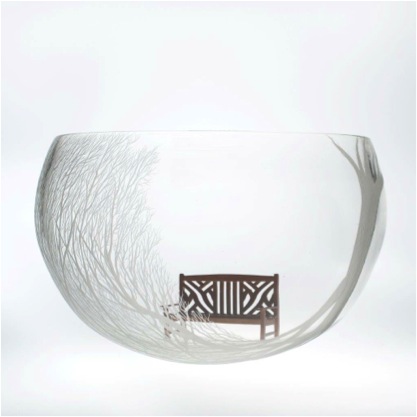
‘When You Smile’
How important is the Australian landscape to your work?
When I first arrived in Australia, I was astonished by the size of the land. In the Australian outback you can see 360 degrees of horizon. The land allows trees to grow huge, yet they do not cover the land completely. The landscape and trees are a motif for my transition to my new homeland. They represent a combination of continuation and change. In Australia, I live among trees: trees are an essential factor for me to feel connected and at home. This experience reminds me of a childhood memory of being among trees, with dappled lights shining between the leaves and branches creating new patterns on the ground.
“Delightful and enlightenment” are two words you use to describe your work can you please elaborate on this?
Martin Heidegger describes language as the ‘house of being’. Language creates us because it creates the way we think of things. We do interact together, we exchange our thoughts and values, we can’t think about something that has no name in the world of matter. It is easy to mistakenly use these associations of cultural background and cultural value to understand the art works on display. I do not wish an audience to judge my works and myself from the cultural background nor its predicted value. My wish is that viewers gain enjoyment and enlightened experiences through viewing my works
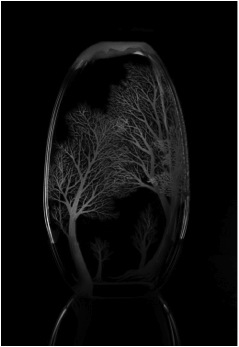
Glass blowing is a very heavy job. Can you explain how you cope with this aspect of your art?
Just like working in any field, in the office, selling clothes or using the computer every day, you get used to it.
You need very specialized equipment for your craft. Can you discuss both the equipment and the space you have to work in?
I have a few hand held micro motors and diamond drill burrs. My work space for engraving is a very small area with a sink and water.
My glass blowing studio is in a large warehouse space with many different type of kilns, furnaces, tools and equipment.
Contact details.
Kayo Yokoyama
P.O.Box 219
Blackheath
NSW 2785
Australia
Kayo Yokoyama, Blackheath, NSW, Australia
Interview by Deborah Blakeley, April, 2013
Think a colleague or friend could benefit from this interview?
Knowledge is one of the biggest assets in any business. So why not forward this on to your friends and colleagues so they too can start taking advantage of the insightful information the artist has given?
Other artists you may be interested in:


